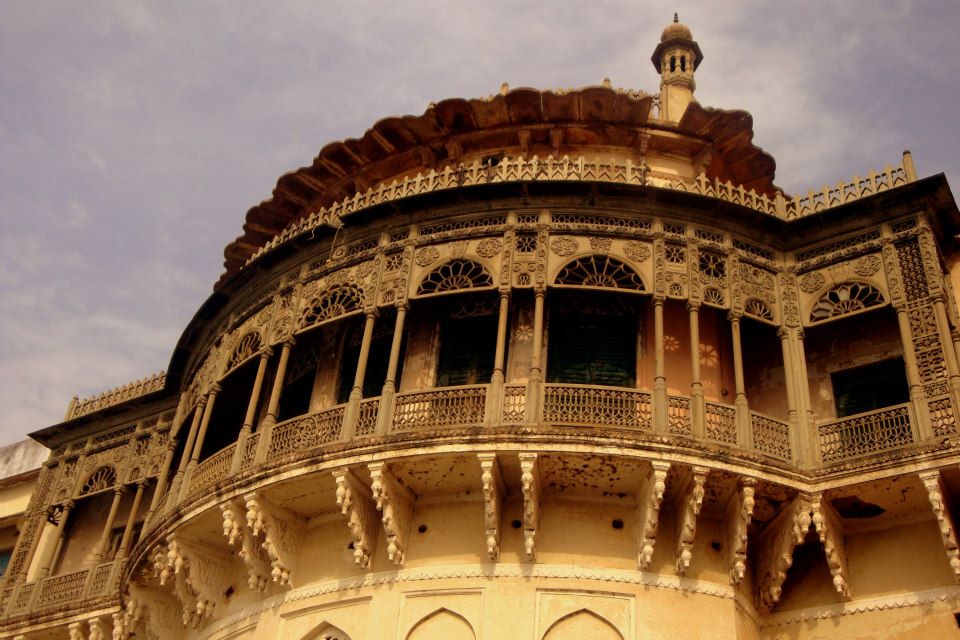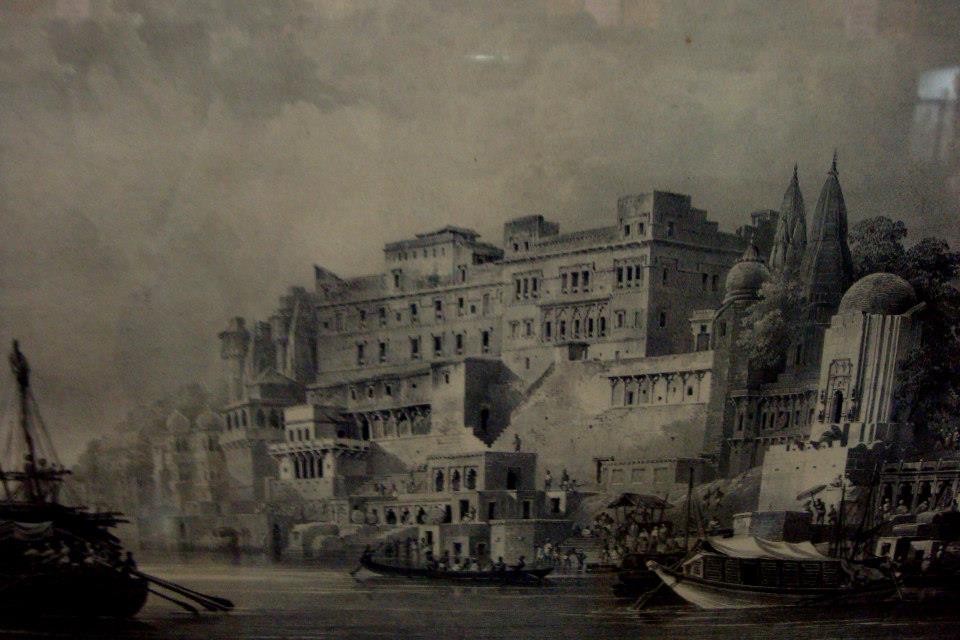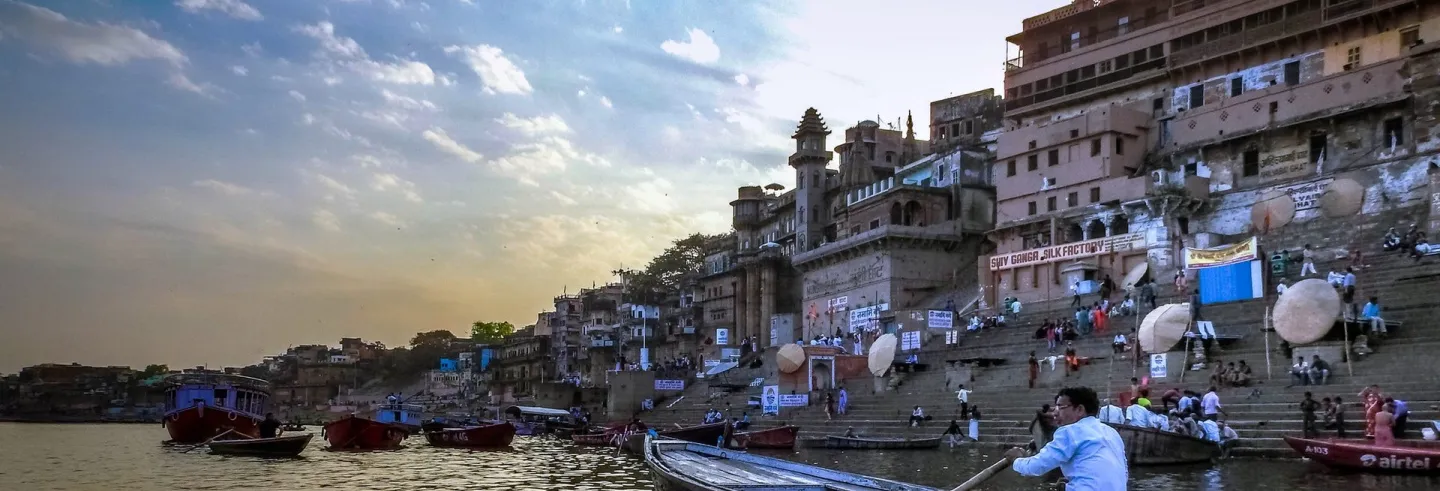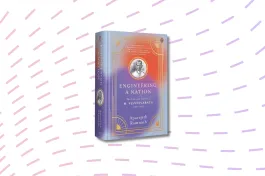My first impression of Banaras was aural. I listened to the city, as it was told to me. The first telling was the memory of a homeland — a great grandfather (five generations ago), Ishan Chandra Roy, was physician to the Maharaja of Banaras, and settled in Ramapura with his extended family. My grandfather’s telling mapped out the household and its locale visually — the mansion with its tahkhana (cellar), the adjoining family temple of Rudreshwar, and the serpentine lanes leading to the ghats.
Ramapura became a palimpsestic stage, frequented by different characters- “actors, pilgrims, kings and gods.” 1 Kapur, Anuradha. Actors, Pilgrims, Kings, and Gods: The Ramlila at Ramnagar. Seagull Books, 1990. In the voice of a master raconteur, rewound and replayed in my mind’s recorder, I touched the seams of migration and settlement, remembrance and dismemberment. The Banaras I constructed was that of the Kayastha gentry — men refashioning their indigene masculinity in the akharas (gymnasium), riding phaetons, posing for studio photographs, and receiving kinkhabs (brocade) as gifts for their wives. Besides, generations of Bengali children would grow up thinking of Kashi as home to an enigmatic pishima (paternal aunt), widowed early in her life, now a cranky crone draped in white, her life devoid of maachh (fish), mangsho (meat) and men. She came to be known as kashi-bashi, or the one who dwells in Kashi. Other fleeting images that conjure the pishimasque city are of the Dashashwamedh ghat, and the uncountable shrines that dot a sacred geography.
Piety rules over pleasure in our simplistic imagination of Banaras — sacrosanct and performatively religious. I had to wait for Mani Kaul’s 1989 classic ‘Siddheshwari’, on the life of the eponymous singer, the prima donna of Purab-ang gayaki, to unfold the sensuous and erotic in Banaras, delicately encoded in a whip of the sarangi bow, the slow chewing of paan and the untimely call of the peacock. It is through successive acts of cleansing that the peacock is silenced, or asked to sing a singular sanitised song. The colourful threads of the julahas dismembered, the city attains an “older than history” timelessness, becomes synonymous with a singular dharmic way of life, rendering the historic fabric altered beyond recognition. How does such an outlandish fabric come into being? What goes into the statist cordoning and re-fabrication of the sites of memory, what Pierre Nora calls lieux de memoire, dispossessed of their erstwhile milieux de memoire (real environments of memory)? What traditions are invented in the name of timelessness by the hegemonic national community?
Before Binaries
The 18th century was marked by a process of regional centralisation of political power in Awadh, a province of the Mughal state. Christopher Bayly notes a proliferation of markets and towns, and the crafting of local networks by mercantile communities. Banaras, in the 18th century, saw an intense scramble for power between people belonging to different communities. Before the coming of colonial modernity, individuals carried multifarious identities, and ‘performed’ these overlapping and at times conflicting identities depending on the specificities of their context(s), as we shall see. This was prior to the taxonomic canonization of identities by means of imperial knowledge production. The most common example of such compartmentalisation is the tripartite periodisation of Indian History into the ‘Hindu’, ‘Mohammedan’ and ‘British’ periods in James Mill’s The History of British India (1818). We have to be sensitive to the self-fashioning of our early modern actors in 18th century Banaras, and be careful of both colonial representations and the communal histories being peddled by the current political dispensation and its ideological allies.
[S]paces like Banaras [are] contact zones of different cultures, that were accommodated through processes of conflict, confrontation and negotiation.
The world of 18th century Banaras, with innumerable actors playing multiple roles in different locales, was by no means a utopia of peaceful cohabitation. Writing the history of the narrative refashionings of the Turkic conquest of North India, Shahid Amin remarked that “the hermetically cloistered figures of rosary-fondling Sufis (saints) and saber-rattling ghazis (warriors), even when yoked to the cause of good pluralistic politics, produce bad history.” Amin’s work alerts us to see spaces like Banaras contact zones of different cultures, that were accommodated through processes of conflict, confrontation and negotiation.
My first visit to Ramnagar, the fortress-palace of the Rajas of Banaras, was a jolt to the image of the Hindu ruling house that I had in my mind. The Rajas projected themselves as the upholders of the Hindu faith and patrons of classical Sanskritic learning while simultaneously participating in folk theatrical traditions like the Ramlila and readings of Tulsidas’s Ramcharitmanas. The sacred landscape of Banaras was a cosmos in which they ruled as the regents of Vishwanath. Their material culture was incurably cosmopolitan, quite beyond my cloistered imagination. I remember seeing velvet envelopes and scroll holders with exquisite zardosi and wire embroidery, salma-sitara work and kinkhab coverlets, takht-posh and huqqah mats, with a rich array of naqshas from across cultures, like the Awadhi mahi-pusht (fish scale) and paisley motifs.
Philip Wagoner, in his 1996 essay, evocatively titled “Sultan Among Hindu Kings” 2 Wagoner, Phillip B. ""Sultan among Hindu Kings": Dress, Titles, and the Islamicization of Hindu Culture at Vijayanagara." The Journal of Asian Studies 55, no. 4 (1996): 851-80. , studied the court dress and titles of the Vijayanagar elites to understand the process of transculturation in early modern Deccan, what he has called ‘Islamicization’. In this, he draws from Marshall Hodgson’s idea of the ‘Islamicate’, as distinct from the ‘Islamic’. 3 Hogdson, Marshall. The Venture of Islam Volume 1. University of Chicago Press, 1974. The Kabayi (long tunic) and Kullayi (conical cap of brocaded fabric) worn by the Vijayanagara elite in courtly settings was a political strategy stemming from their participation in a “universal” culture of Islam, and related more to “standards of taste” in a social and cultural landscape, a complex of material aesthetics, comportment and performance as opposed to the hegemonic imposition of religion. He debunks the historiographical notion of the Vijayanagara state as “a Hindu bulwark against Muhammadan conquests”, articulated by Robert Sewell in 1900, and uncritically inherited by the nationalist historians.

Similarly, the Bhumihar Brahmin ruling house of Banaras, steeped in Hindu traditions and practices in the ritual domain, was not merely a patron of revivalist classical ‘Indic’ traditions, but also of a material culture that was already highly transcultural. This is not to suggest that their fashioning was mindless or innocent, or there was no awareness, for instance, that a julaha belonged to the Muslim ‘community’. Rather, it acknowledges that multiple processes go into the making of a composite culture to which we ascribe overarching teleological models. The inherited lifestyle of being a Nazim appointed by Muhammad Shah, and being a repository of the maryada or “personal dignity and social propriety” of the ideal ruler Ram 4 Lutgendorf, Philip. The Life of a Text Performing the Ramcaritmanas of Tulsidas. University of California Press, 1991. were not mutually exclusive or conflictual modes of kingship for the Bhumihar kings.
Tracing Fault Lines
No trip to Banaras is complete without the sight of the Banarasi weaves. On the streets leading to the Chawk, the fabled shikargah motif with its caparisoned elephants and traumatised antelopes, woven into the sheen of katan and kora, preserves the memory of the hunt in an altered cultural ecology. Motifs reproduce the thrill and tragedy of the royal hunt in a post-colonial world. In 2012, as we drove to Madanpura, one of the older weavers’ neighbourhoods, mostly inhabited by Ansaris, our well-meaning driver informed us that it was a “Muslim area”. And visibly so: men in skull caps, goats moored to houses, and the sound of the azaan in the mellow light of dusk. Or did I hear the azaan in the realm of memory, just because I was told about the ‘Muslimness’ of the locality?
[A] mohalla in Banaras is identified by the occupation that predominates there, and rarely by the majority community in terms of religion, sect or language.
Looking back, I wonder how does one experience neighbourhoods, ones that are different, that are beyond the familiar civic-scapes of imagination? I was born in a so-called secular neighbourhood in south Calcutta, a neighbourhood of upper caste Hindu households voting for the CPI(M), yet some of them making use of a separate staircase for cleaners belonging to the ‘Methar’ community. Madanpura reminded me of the “Muslim majority” localities around Park Circus in my hometown, with their China mosaics and bright popular wall images of Buraq. Madanpura had no such images or mosaics, but my mind clubbed the two ‘others’ together. Were neighbourhoods in Banaras always sealed into community-based enclaves? Or is it the cartography of my mind that knows no lines but borders?
Nita Kumar, in her work The Artisans of Banaras (1988), tells us that a mohalla in Banaras is identified by the occupation that predominates there, and rarely by the majority community in terms of religion, sect or language. Bengali tola would explicitly count as one of those rarities to which Kumar alludes, where the mohalla was identified with a community residing there. She notes that outsiders identify a mohalla by either a temple, mosque, mazar, haveli, akhara, or a pond where a seasonal mela is held.
The self-identification of the residents of a mohalla happened through collective participation, and the use of shared spaces, in temples and mazars, wrestling matches and mushairas. Writing about Adampura and Jaitpura, the two other weavers’ neighbourhoods, Kumar notes that they display the same features as the old “Hindu localities”. Ansaris share with other craftsmen like the kaseras or metal workers the urbane and cultured self-image that the residents of the old city deem respectable. While religion is one of the many elements of everyday life, neighbourhood identities also stem from the experience of work and other social affiliations.
In her study of the 18th century text Balwantnama, Vasudha Dalmia notes that even while describing a temple-mosque dispute in Jaunpur (which was administered by the Raja of Banaras), the author, Fakir Khairuddin Muhammad, doesn’t refer to the disputing individuals as Hindus or Muslims. Instead he identifies them by their jati names like Rajput, Gautam Brahman, and the Muslims simply by their names. Even though no homogenous group of Hindus and Muslims emerges, in certain situations individuals assume religious identities. Dalmia concludes that it is the intervention of the state that determines the course that such disputes take, and the future articulation of such identities. Strife might fizzle out after momentary ruptures, or manifest in longue durée hostilities and prejudices against communities.
While the role of the state in both restraining and fostering rigid identities and hostilities is undeniable, it is important to think about the very idea of the state, and not essentialise it. Instead of viewing the state as unilaterally intervening in situations of social disorder, disorders should be seen as intrinsic to power relations that go into the making of the state, as a process. 5 See Hasan, Farhat. State and Locality in Mughal India: Power Relations in Western India, C.1572-1730. Cambridge University Press, 2004. The idea would be to see governance and politics as processes.
The Unmaking of Banaras and the New Kashi Corridor
The textbook image of Bharatendu Harishchandra, the 19th century litterateur deservedly hailed as the father of modern Hindi prose, is that of a revivalist. More of an archaeologist, I would say, for he is credited with having resuscitated the “pure” language, situating its roots in a long lost Sanskritic culture of the Aryans, the original inhabitants of Bharatvarsha, as opposed to a decadent Hindustan. Yet, a medallion portrait in the Company style, sold by the Bombay based auction house Pundole’s, features him in a richly embroidered angrakha with a crown cap of softly pleated cloth, lined with exquisite naqsha in gold.
In another studio photograph, he is seen locking eyes with his ravishing companion Mallika, the young Bengali widow who became an important part of his literary life. His participation in the world of tawaifs, and of Banaras’s mercantile rais culture, was very much a part of the ‘decadent’ Hindustan that he so despised, as opposed to the awakening Bharatvarsha. This milieu of contradictions that characterised Banaras would produce characters like Premghan, Rai Chagan, GauharJaan, Rai Krishnadas, Husna among others.
Underscoring Bharatendu’s apparent contradictions is a liltingly sweet Kajri. Set to music and sung by the inimitable Girija Devi (Appaji to Banaras, and her students) — Kahanwa mano ho Radharani — was penned by Bharatendu. Appaji once narrated how she replaced Bharatendu’s original ‘dil-jani’ (the knower of heart) with the devotional ‘Radharani’. I was struck by Bharatendu’s use of an Urdu composite, because school textbooks paint him in a single Hindi-ising hue. Later I would discover that he wrote Urdu ghazals using the takhallus (nom de plume) of ‘Rasa’, and here’s a rubai (quatrain) by ‘Rasa’:
// baḳht ne phir mujhe is saal khilāī holī soz-e-furqat se zi-bas mujh ko na bhaaī holī shola-e-ishq bhadaktā hai to kahtā huuñ 'rasā' dil jalāne ke liye aah ye aaī holī // (Destiny again made me play Holi, In the lament of separation Holi didn’t please me, The flames of passion flare, says ‘rasā’ To burn my heart has come Holi) 6 bakht ne phir mujhe is sal khilai holi, Rekhta, translation mine. I failed however, to translate the searing ‘aah’ in the fourth line; thanks to Malik Irtiza for bringing it to my notice.
While the visual afterlife of Bharatendu and the poetry from the pen of ‘Rasa’ are remnants of a cosmopolitan culture, he also lived the life of the textbook Harishchandra, with an emphasis on the epithet ‘Bharatendu’. In his satirical work Urdu ka Syapa (The Lament of Urdu) published in 1874, he lashed out at Urdu newspaper editors for their stance against the movement to introduce the Nagari script for administrative work. The script controversy, stoked by Babu Shiv Prasad, found new torchbearers in Harishchandra and Madan Mohan Malaviya. This in turn would lead to the establishment of organisations like the Nagari Pracharini Sabha and Anjuman-iTaraqqi-i Urdu, gradually consolidating the linguistic divide.
It is interesting to note that regional scripts used by Kayasthas and other scribal and mercantile communities were also obliterated in favour of Nagari characters a “pure” Sanskritised Hindi. In 1902, the Nagari Pracharini Sabha denied support for the promotion of Kaithi. J.C. Nesfield, the Director of Public Instruction for Oudh and a sympathetic proponent of Kaithi, wrote in 1876 that Kaithi lacked the association that Nagari shared with Sanskrit, the scriptural language used by the Brahmans, and thus lacked the larger religious overtones that were intrinsic to the project of linguistic sanitisation 7 King, Christopher R. One Language, Two Scripts The Hindi Movement in Nineteenth Century North India.Oxford University Press, 1994. Pg. 67 .
As in other cities, anti-colonial nationalism, had an indelible religious colour in Banaras.
While the destiny of a new Bharat was to be scripted in Nagari, its sensibilities were derived from the old and timeless: Aryan, Hindu and Sanskritic. As in other cities, anti-colonial nationalism, had an indelible religious colour in Banaras. An example of this is the iconography of Bharat Mata, both in its anthropomorphic form depicting the country as the Hindu feminine force or Shakti 8 On the iconography of Bharat Mata, see Bose, Sugata. The Nation as Mother: And Other Visions of Nationhood. Penguin, 2017. ,and in the sacralisation of its cartography, as in Shiv Prasad Gupta’s Bharat Mata Mandir.
Over the next eight decades, Banaras would witness a series of polarisations, consolidation of communal identities, and attain the image of an overwhelmingly “Hindu city”, reiterated even by scholars like Diana L. Eck. The demolition of the Babri Masjid in Ayodhya, led by the Bharatiya Janata Party and its allies, would stir a process of “grievance-collection” 9 See Subrahmanyam, Sanjay. “Violence, Grievance, and Memory in Early Modern South Asia” in Explorations in Connected History: From the Tagus to the Ganges. Oxford University Press, 2005. by invoking the historical wrongs done by Muslim conquerors in the past. A new battle cry to avenge the victims, upper-caste Hindus, would resonate louder in the absence of livelihood opportunities, while the unbridled masculinity of frustrated, unemployed individuals would be organised into militant groups of sword-flashing foot-soldiers — Hindutva’s military labour market in North India.
Reclamation of Hindu sacred sites desecrated by Muslim rulers would be rationalised as a call for justice within the structures of modern legality. After the demolition of Babri Masjid, Kashi and Mathura would become the imminent targets, to undo the atrocities of Awrangzeb, one of the most hated of pre-modern Muslims, at par only with Mahmud of Ghazni and Ala al-Din Khalji.
Awrangzeb ordered the demolition of the temple of Vishwanath in 1669. Catherine Asher notes in her work that the demolition was motivated by the rebellion of zamindars in Banaras with possible links with Shivaji, and recent reports of Brahmanical interference with Islamic learning. A punitive measure to keep local power-holders in check could involve acts of iconoclasm and the desecration of sites of power. But to reduce it to religious intolerance alone, would be remiss of the modern historian. The likes of Awrangzeb become villains emblematic of the community of Muslims, now vilified. The aggrieved majority, oppressed under ‘foreign’ rule for centuries, resorts to retributive justice.

On 8 March 2019, the Prime Minister, Narendra Modi, inaugurated the Kashi Vishwanath Corridor Project, for which 45,000 square feet of land around the historic temple has been cleared. The Prime Minister, in his inaugural speech 10 Excerpts of the speech transcribed and translated from the video "PM Modi lays the foundation stone of Kashi Vishwanath Temple Corridor in Varanasi" uploaded by the PMO on YouTube. said that it was a call from a stifled “Bhole Baba” to clear the congestion around the temple for the deity to breathe - “Bhole baba ko mukti milegi” (the deity will be liberated/be able to breathe freely).
The eviction of residents around the temple was justified in the name of rescuing the divine. “For centuries, this place has been the target of enemies, has been devastated, has lived without its existence [essence?], but the faith of this place [people] has given it new births, resurrected it, and given new consciousness…,” he said, with a demagogic emphasis on enemies. In crafting genealogies of pietistic power, he invoked Ahilya Bai Holkar’s role in the resurrection of the Vishwanath temple, and also at Somnath, another Jyotirlinga serially desecrated by Muslim rulers in the medieval period. Through the use of allusions embedded in popular memory, a connection between two protectors as opposed to the enemy-invaders was made, with great emphasis and artifice. A similar address was made by the current Prime Minister’s ideological and portfolio predecessor, Atal Bihari Vajpayeee, at Somnath on October 31, 2001. 11 See, Kumar, Sunil. Demolishing Myths or Mosques and Temples? Readings on History and Temple Desecration in Medieval India. Three Essays Collective. 2008
Further, the Prime Minister stated that hidden temples have been unearthed from within households, and they have been exposed as independent structures, after the demolition of the residential spaces. One could see the demolition of these residences as a desecration too. It severed that intimate link between the divine and earthly, the experience of living with Gods that emanates from a household shrine. But the worshipped as a part of the quotidian is clearly at odds with the Hindutva way of experiencing the divine, which is to arm one’s God to terrorise the ‘Other’.
I wonder if the karsevaks who thronged to Ayodhya with glistening swords, responding to the call of Lal Krishna Advani, ever imagined their lord swinging in the rains by the Saryu river, clad in silk, mischievously, boyishly slender, even delicate. The mob that wanted to pulverise Faiyyaz Khan’s tomb in 2002, had they never heard his classic Vande Nandakumar? In a situation where no stone will be left unturned to divide Banaras to the point of rupture, can we hope that the visions of Tulsidas and Shyamdas, their songs of their “Raamlalana” cradled in the poignancy of Tilak Kamod and Kafi will disarm the mob?
I thank Moksh Kalra for commenting on an earlier draft. This essay owes a lot to Vidya Rao. She has seen it through the long gestation period, and I am indebted to her for her careful reading and ideas, and much more.
Write to editor@theindiaforum.in.










